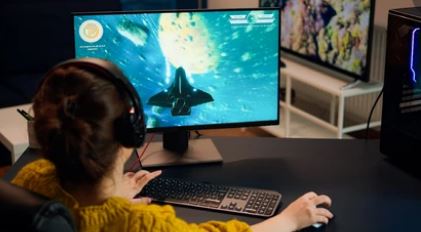By: Eric Young, RPSGT
Exiting the pandemic, there’s been an increase in electronic media consumption. More people are on TikTok, connecting through Facebook, and, of course, playing video games. A 2019 survey[1] by CommonSenseMedia.org showed 56% of 13 to 18-year-olds are playing video games, consuming an average time of nearly three hours a day. The importance of sleep in teenagers is well known, and the AASM has released a consensus statement encouraging up to nine hours of sleep for young adults. Given that teenagers spend so much time playing these games, do video games have a role in sleep and what portrayal does sleep have in these games?
Role Playing Games (RPGs) often follow a hero, or a party of heroes, as they trek across lands unknown, like the ever popular Lord of the Rings. Games like Final Fantasy, Secret of Mana, and the Ultima series depict sleeping as an opportunity to restore health, spirit and are often opportunities to save the progress of the game. These correspond well with what we know in terms of sleep’s benefits to memory, fitness and mental acuity. Often, players are encouraged to sleep at inns, and the quality of sleep may determine the restorative quality.
Gaming is not the first to highlight the benefits of a good night’s rest. Clearly, sleep and its benefits are a reflection of how developers externalize restfulness as a game mechanic. But there are plenty of other normal bodily necessities: waste management, caloric intake, and personal hygiene, which rarely appear as frequently or as ubiquitous as sleep does.
Even in pure fantasy, Dungeons and Dragons players may recognize that a long rest allows for players to regain their ability to cast magical spells. While a long rest isn’t specifically sleep, it is defined as a period of extended downtime for at least eight hours, during which they are allowed to sleep, or perform any light activity for no more than two hours. This follows our known guidance of six to eight hours of sleep a day.
In more rare situations, survival games, like Minecraft or Terraria will discourage players from going out at night, forcing them to either sit in their dwellings cowering from nocturnal monsters or skip the night phase entirely by going to sleep. The popular farming game, Stardew Valley, will simply cause the player to pass out from exhaustion at 1:00am, regardless of how much energy they have left.
These examples are not meant to imply that people who play games are more inclined to sleep. In fact, there is research which indicates daytime and bedtime use of electronic devices increased risk of short sleep duration, longer sleep onset and increased sleep deficiency (Hysing et al. December 2014)[2].
Massively Multiplayer Online (MMO) games have struggled with their players playing too much. These are games in which communities of players play together in a virtual world, compounding peer pressure to play more. To address this, in the beta of World of Warcraft there was a Fatigued status. Players who spent too much time collecting experience would gradually be rewarded with less experience. When online fervor rallied against this penalty, the developers brought an identical “Well Rested” bonus, rewarding players for taking a much needed real time break from the game. While the mechanic was designed as a way to curb game progression, and limit play time, the designers chose to use the common themes of rest and fatigue to express to players a more healthy way to engage with the game.
Sleep in popular culture is often seen at the bookends of scenes; the start and finish to a day, but rarely commented on other than the space between. Hustle culture, and machismo attitudes of “I’ll sleep when I’m dead” are prevalent throughout social media. Even comic books depict superheroes who lead double lives, and eschew the wasted time of sleep, promoting an insidious and toxic attitude that challenges our narrative of the importance of time in bed. By contrast, sleep in video games is often valuable, and continues to reinforce the positive benefits for ourselves and our virtual identities.
[1] Rideout, V., and Robb, M. B. (2019). The Common Sense census: Media use by tweens and teens, 2019. San Francisco, CA: Common Sense Media.
[2] Hysing M, Pallesen S, Stormark KM, et al. Sleep and use of electronic devices in adolescence: results from a large population-based study. BMJ Open 2015;5: e006748. doi:10.1136/ bmjopen-2014-006748

